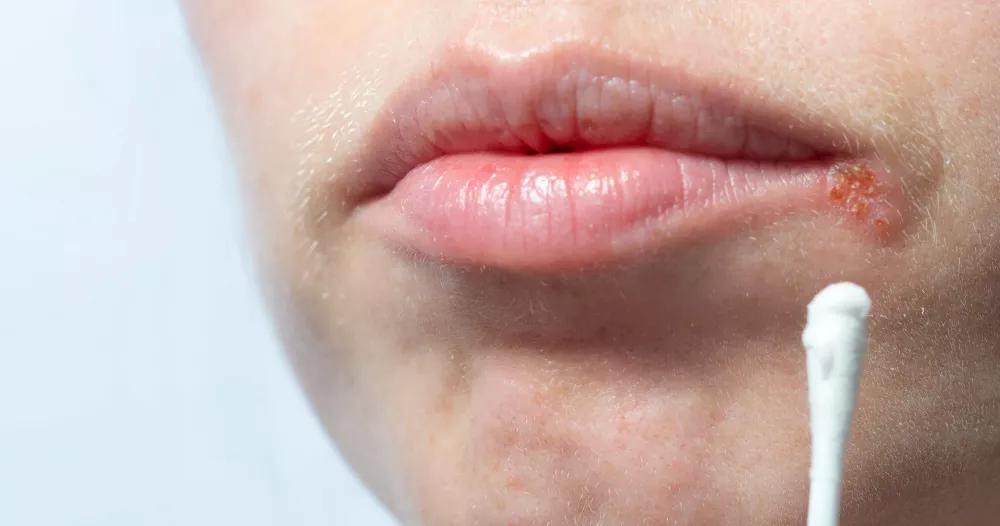Perlèche (lip infection): symptoms, causes and treatments
Definition: what is angular cheilitis?
Also called angular cheilitis, angular cheilitis is an infection that is localized in the lips. "Perlèche is a frequent pathology in dermatology. It most often affects women and children, because they have more fragile skin", notes Dr. Paul Dupont, dermatologist and author of the book Soigner sa peau au naturel (Ed. Eyrolles ).
Figures: how common is angular cheilitis?
In 60% of cases, a fungus is the cause of angular cheilitis.
Symptoms: how to recognize a angular cheilitis?
This infection manifests itself in the form of:
Photo: Perlèche visible in the oval mark
© Creative Commons
Credit: James Heilman, MD — Own work - License: https://creativecommons.org/licenses/by-sa/3.0/
Causes: what triggers angular cheilitis?
"Angular cheilitis is above all a sign of a vitamin B deficiency. But it can also appear during an infection caused by a mycosis (candida albicans type fungus) or bacteria (streptococci or staphylococci)", underlines Dr. Paul Dupont, dermatologist.
"Apart from vitamin B deficiencies, angular cheilitis can reflect a lack of iron or selenium which is often associated with a drop in immunity. In this case, there is anemia and the drop in blood ferritin characterizes the iron deficiency. More rarely, it can appear as one of the predictive signs of diabetes, gastric pathology, or even a drop in immunity", adds Dr Dupont.
Perleche can also be of irritant origin when the person who suffers from it constantly passes his tongue on the side of his lips. Over time, the saliva creates a maceration that causes angular cheilitis.

Sucking the thumb or a pacifier can also promote this irritation, as can the problems of closing the mouth encountered by the elderly who no longer have teeth or who have dental prostheses.
The use of certain lipsticks, toothpastes, irritating or allergenic objects brought to the mouth (nickel object, pencil eraser, musical instruments, etc.) is sometimes blamed.
Micro-injuries, caused by dental care, can also promote this infection.
What are the risk factors for angular cheilitis?
The risk factors are:
Who is at risk of developing angular cheilitis?
Certain ages of life are more likely to be affected by angular cheilitis. This is the case of:
Duration: how long does a angular cheilitis last?
Perleche disappears in 8 days if it is well treated.
Contagion: is Perlèche contagious?
This infection is very rarely contagious.
Perlèche: who, when to consult?
It is the general practitioner who is the privileged interlocutor and who can then refer to a dermatologist if necessary.
What are the complications of angular cheilitis?
Complications of angular cheilitis take the form of:
Perlèche: what examinations and analyzes are necessary?
The diagnosis is made through a simple clinical examination, sometimes accompanied by the analysis of samples taken from the corners of the lips. These samples are examined directly under a microscope and then placed in culture.
The result is fast if a germ is involved, but requires more time if it is a fungus. If angular cheilitis resists treatment, your doctor can recommend a biological check-up.
Treatments: how is a angular cheilitis treated?
Prevention: how to avoid angular cheilitis?
"It is necessary to avoid vitamin B deficiencies first of all, by supplementing with food supplements of natural origin. And this whenever one can find oneself in the conditions that lead to a vitamin B deficiency such as stress, overwork or taking contraceptives,” advises Dr Dupont.
Other gestures make it possible to prevent this cutaneous infection or to avoid its reappearance. Thus, it is necessary:
Persistent angular cheilitis: what solution?
The advice of Doctor Paul Dupont, dermatologist:
"It is necessary to have a bacteriological mycological sample taken in order to eliminate an infection, but also to look through a blood test for a possible iron deficiency and an increase in blood sugar. If the angular cheilitis persists, it is advisable to look for a digestive mycosis by prescribing a stool analysis.Finally, as a local treatment, sodium bicarbonate lotion, then the application of a liniment is indicated.If the angular cheilitis does not disappear after a few days of these dermo-cosmetic treatments, consult a dermatologist".
Information sites and associations
French Society of Dermatology. https://www.sfdermato.org
How to apply blush to change your face
GO
6 make-up brands available exclusively in Belgium
GO
Allylikes Spring Wear Complementary Ideas to look Fashion
GO
Bic pen, Duralex glass, Laguiole knife... thirty dream objects, designed and manufactured in France
GO